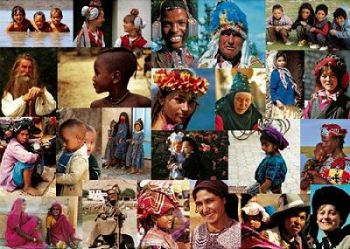Culture is a broad concept that represents the set of traditions, beliefs and customs of a particular social group. It is passed on through communication or imitation to subsequent generations.
In this way, culture represents the social heritage of a group, being the sum of patterns of human behavior and involving: knowledge, experiences, attitudes, values, beliefs, religion, language, hierarchy, spatial relationships, notion of time, concepts of universe.
Culture can also be defined as behavior through social learning. This dynamic makes it a powerful tool for human survival and has become the central focus of anthropology since the studies of the British Edward Tylor (1832-1917). According to him:
"Culture is all that complex that includes knowledge, beliefs, art, morals, law, customs and all other habits and abilities acquired by man as a member of society".
Culture in Sociology
Culture in sociology represents the set of knowledge and traditions of a people. These are produced by social interaction between individuals in a community or society.
Based on human needs, patterns and behaviors that generate a certain structure and social organization are shaped and created.
Remember that no culture should be considered superior to another. What do exist are cultural differences between the different groups. When making a value judgment about some aspect outside their culture, we may be being ethnocentric.
O ethnocentrism it occurs when we consider our habits or behaviors superior to those of others and this can generate unfounded prejudices.
Read too:
- What is Social Interaction?
- cultural relativism
7 Types of Culture
1. mass culture
Mass culture is the set of ideas and values that develops from the same media, news, music or art as a starting point. It is transmitted without considering local or regional specificities.
Mass culture is used to promote consumerism among individuals, being a typical behavior of capitalism, which was drastically expanded from the 19th and 20th centuries.
See too: mass culture
2. high culture
Unlike mass culture, high culture is the result of knowledge acquired through research and study in different fields.
It is not offered massively, it is available to a few and represents a form of social differentiation made possible by access to knowledge. As examples, we have: artistic exhibitions, theatrical presentations and concerts.
See too: high culture
3. Popular culture
Popular culture is closely related to traditions and knowledge, which are determined by the people, for example: festivals, folklore, crafts, music and dance.
In opposition to high culture, it occurs spontaneously and organically. Therefore, it is not associated with cultural facilities, such as museums, cinemas, libraries, etc.
See too: Popular culture
4. material culture
Material culture represents the set of cultural and historical heritage formed by concrete elements that over time were built by human beings.
Examples of material culture include architectural elements (churches, museums, libraries) and objects for personal and collective use (works of art, utensils, clothing).
See too: Historical Heritage
5. immaterial culture
Unlike material culture, immaterial culture is formed by intangible elements. It represents the set of knowledge, traditions, techniques, habits, behaviors, customs and ways of doing of a given group.
Considered a cultural heritage transmitted between generations, we have as examples the folklore legends, the popular fairs, the rituals, the dances, the cuisine, etc.
See too: material and immaterial culture
6. Organizational culture
Organizational culture, also called "corporate culture", brings together a set of elements associated with the values, missions and behaviors of a given organization.
Within the context of globalization and market studies, this type of culture created patterns of functioning and operations, for example, within a company.
See too: Organizational culture
7. body culture
Body culture analyzes the behavior of human beings in their most different groups. It brings together practices related to movement, such as dances, games, activities, sexual behavior and festivities.
Elements of Culture
Associated with material and spiritual values, the cultural elements are:
1. Elements of Material Culture
Associated with tangible, concrete and palpable elements constructed by human beings.
As examples of material culture we can cite constructions and objects: museums, churches, works of art, clothing, utensils, etc.
2. Elements of Intangible Culture
Related to the intangible and spiritual elements of a group, immaterial culture represents the knowledge, ways of doing and values shared among the members of a society.
As examples, we can cite rituals, legends, festivals, language, cuisine, etc.
Culture Characteristics
- determined by the set of knowledge, behaviors and ways of doing;
- it has a symbolic character;
- it is acquired through the social relationships of a group;
- is passed on to later generations;
- it is not static, being influenced by new habits.
Brazilian culture
THE Brazilian culture it results from the mixture of races and ethnicities that have constituted the country since its discovery.
Brazilian cultural diversity was influenced by four major groups:
- Portuguese settlers;
- The Indians who already lived before the arrival of Pedro Álvares Cabral (1467-1520);
- African blacks who were enslaved;
- Europeans who have mostly reached the end of the period of exploitation of unpaid labor.
Unlike most countries that went through the colonization process, Brazil is marked by the miscegenation, a condition that directly influences the culture.
There are behaviors that result from mixing multiple groups. We can see this reality in parties, etiquette and beliefs.
The Portuguese language, which is an important element of national unity, is also among the highlights of Brazilian culture.
As a result of the geographic dimensions, the different groups that settled in the country influenced the language in a particular way. Thus, there are intonations and expressions that point to the most varied regions.
Although it is the same, the language is pronounced differently in the South, Southeast, North, Northeast and Midwest. All differ from the Portuguese spoken in Portugal.
Learn more about culture:
- cultural identity
- Cultural diversity
- acculturation
- Cultural appropriation
- questions about culture


